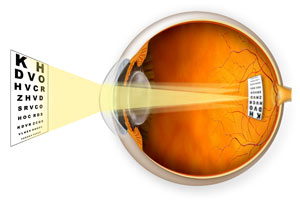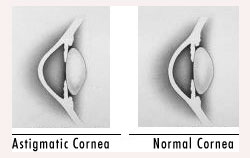Astigmatism

Astigmatism is a vision problem that causes blurred or ‘distorted’
vision. It is quite common and often occurs together with myopia or
hyperopia in the same eye.
For clear vision, the cornea and the
lens must properly focus (or refract) light to one point on the retina.
Normally, the cornea is smooth and equally curved in all directions.
However, with astigmatism, the cornea is usually 'warped', meaning it
curves more in one direction. Thus, the irregular shape prevents light
from focusing properly on the back of the eye, the retina. Instead, the
light is focused on two points at the back of the eye, rather than just
one. As a result, a person's vision may be blurred at all distances, as
objects appear somewhat indistinct and slanted.
Astigmatism is
often present from birth, as some people are born with warped corneas.
However, astigmatism can also be due to pressure of the eyelids on the
cornea, corneal scars, or keratoconus, to name but a few. Of important
note is that astigmatism does have a hereditary component, i.e. if one
or more parents have astigmatism there is a greater risk that their
children will have it as well.
The most common symptoms of
astigmatism are headaches and fatigue. Squinting, eye discomfort and
irritation are also frequent. Astigmatism can also cause images to
appear doubled, particularly at night. As well, patients tend to have
inconsistent difficulty focusing on various objects, including printed
words and lines at all distances.
Treatment

An optometrist
or ophthalmologist can easily diagnose astigmatism. Once diagnosed, the
treatment for astigmatism depends on several factors, including the
patient's age, activities, and occupation. Glasses and contact lenses,
which allow the light to be focused properly on the retina, are the most
common method used to correct most astigmatism. However, many patients
with astigmatism can achieve better vision with specifically designed
toric contact lenses. Laser surgery is another option, which obviates
the need for glasses and contact lenses; however, it can only be used to
correct low to moderate astigmatism.
|